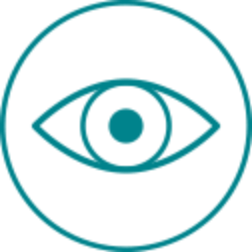Actual patient and caregiver.
Actual patient and caregiver.

Visual function
Structural and functional changes at the organ level1
For example, rod dysfunction results in night blindness2

Functional vision
Vision-related quality of life, including skills, activities of daily living, and social participation1
For example, night blindness limits individuals’ ability to navigate in dimly lit environments, such as a crosswalk at night2
Study description:
The randomized, controlled, open-label, phase 3 trial included 31 patients, aged 4-44 years. Patients were eligible to participate if they were 3 years of age or older, had a genetic diagnosis of biallelic RPE65 mutations, sufficient viable retinal cells, VA of 20/60 or worse in both eyes and/or VF less than 20 degrees, and were able to perform the MLMT within the luminance range evaluated, but unable to pass at the lowest light level (darkest). Patients were randomized into control (n=10) and intervention (n=21) groups. Prior to intervention, 2 patients discontinued the trial, resulting in an intent-to-treat (ITT) population (n=31) and a modified intent-to-treat population (mITT) (n=29). The intervention group received the first injection of LUXTURNA (first eye) and within 6-18 days later received the second injection (second eye). Placebo injections were not given to patients in the control group. Patients receiving LUXTURNA followed a perioperative immunomodulatory regimen to reduce risks related to immune response. Efficacy endpoints were assessed 1 year after the second injection. At 1 year, the control group crossed over and followed the same treatment schedule as the intervention group.4,5
>100-fold improvement in light sensitivity4,5
A statistically significant difference in FST monocular averaged over both eyes of -2.11 log10 (cd.s/m2) (95% CI: -3.19, -1.04) between groups4,5*†
8-letter improvement in VA4,5
A nonstatistically significant difference in VA monocular averaged over both eyes of -0.16 LogMAR (95% CI: -0.41, 0.08) in the intervention group, compared with 0.01 LogMAR in the control group4,5*‡
Nearly doubled VF in sum total degrees4,5§
A statistically significant difference of 378.7 sum total degrees between groups (95% CI: 145.5, 612.0)4,5*||
Increased VF by nearly 8 dB4,5
A statistically significant difference in macula sensitivity thresholds of 7.9 dB between groups (95% CI: 3.5, 12.2)4,5*¶
